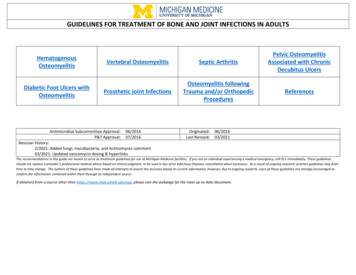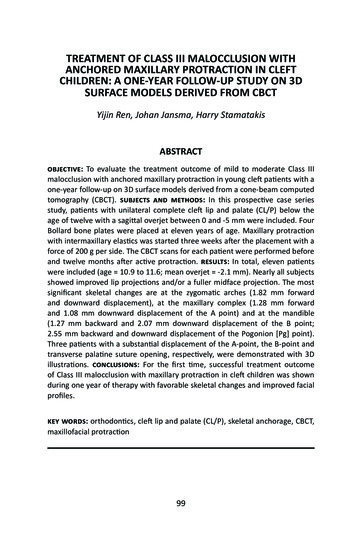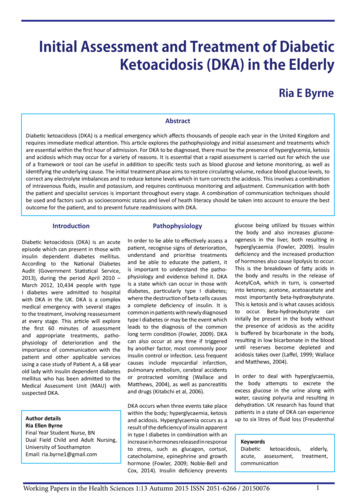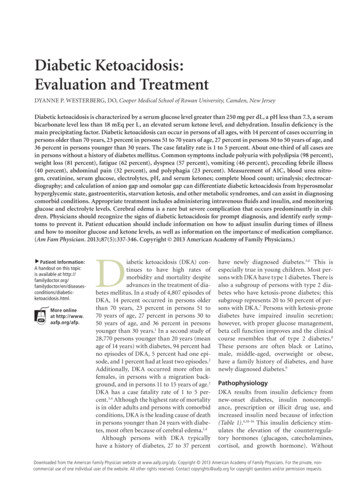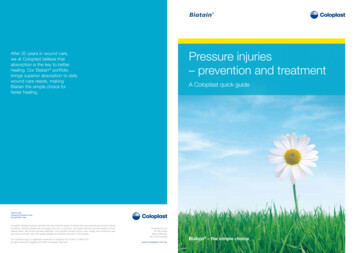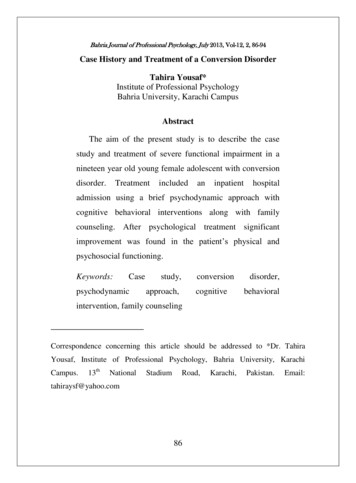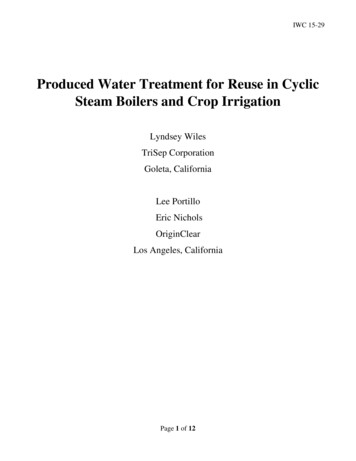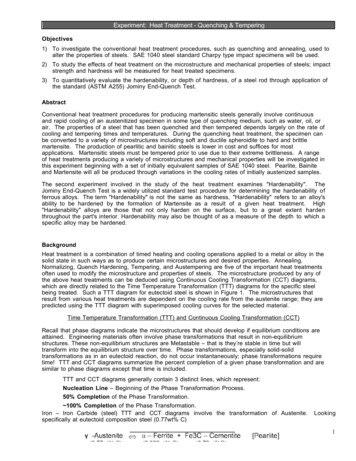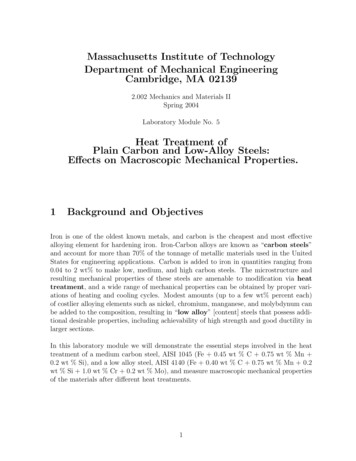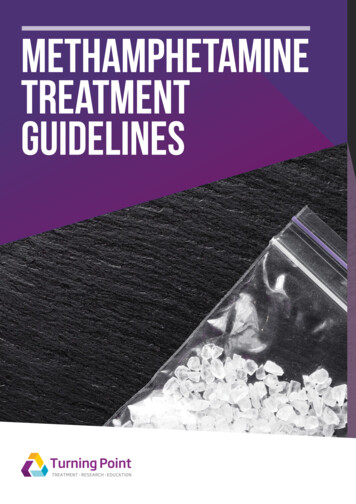
Transcription
METHAMPHETAMINETREATMENTGUIDELINES
MethamphetamineTreatment GuidelinesPractice Guidelines for Health ProfessionalsSecond EditionJasmin GriggVictoria ManningShalini ArunogiriIsabelle VolpeMatthew FreiVicky PhanAdam RubenisStephanie DiasMargret PetrieMichelle SharkeyDan I LubmanCopyright 2018 State of Victoria.Second Edition printed 2018.ISBN (print): 978-1-74001-028-3ISBN (ebook): 978-1-74001-029-0Copyright enquiries can be made to Turning Point, 110 Church St, Richmond, Victoria 3121, AustraliaPublished by Turning Point, funded by the Victorian Department of Health and Human Services. Theviews of the authors do not necessarily reflect the views and position of the Department of Health andHuman Services.The correct citation for this publication is: Grigg J., Manning V., Arunogiri S., Volpe I., Frei M., Phan V.,Rubenis A., Dias S., Petrie M., Sharkey M. & Lubman D. I. (2018). Methamphetamine Treatment Guidelines:Practice Guidelines for Health Professionals (Second Edition). Richmond, Victoria: Turning Point.1Methamphetamine Treatment GuidelinesTurning Point
OVERVIEWThe Methamphetamine Treatment Guidelines havebeen developed by Turning Point to assist Victorianhealth professionals in the clinical managementof methamphetamine use disorder and relatedpresentations. These guidelines also aim to improveunderstanding of methamphetamine use disorder inhealth services and the community.The first edition of these guidelines was published in2007, and outlined acute and longer-term interventionsfor methamphetamine use problems available atthe time. Recent changes in methamphetamineuse patterns, from lower-purity powder to highpurity/potency crystal methamphetamine, has beenaccompanied by increases in methamphetamine-relatedharms and complex presentations. This shift, along withsubstantive changes to the diagnosis and classificationof substance use disorders, has necessitated the revisionof these guidelines.The 2018 updated guidelines provide recommendationsbased on current evidence and best practice for themanagement of methamphetamine use disorder(chronic use and withdrawal). These guidelines includethe management of acute and complex presentations,including behavioural disturbances, polydrug use,injecting methamphetamine use, cognitive impairmentand comorbid mental health symptoms, as well asrecommendations for reducing harm, working withspecific populations, and supporting families and carers.2Methamphetamine Treatment GuidelinesTurning Point
ACKNOWLEDGEMENTSThis publication was made possible by the inputof many people who willingly gave of their timeand expertise. Their contributions, in the formof professional advice, suggestions and criticalcommentary, are greatly valued.The authors would like to thank Professor AmandaBaker for permitting the inclusion of the BriefIntervention specifically developed and evaluated forclients who use methamphetamine.In the revision of this resource, Turning Pointacknowledges the considerable contribution of theauthors of the previous version of these guidelines:Nicole Lee, Lisa Johns, Rebecca Jenkinson, JenniferJohnston, Kieran Connolly, Kate Hall and RichardCash. Turning Point also acknowledges the ClinicalExpert Advisory Group who reviewed these guidelinesduring their original development: Amanda Baker,Catherine McGregor, Robin Fisher, Frances KayLambkin, Rebecca McKetin, Ingrid van Beek, SimonRuth, Katherine Walsh and Sue White.3Methamphetamine Treatment GuidelinesTurning Point
t is amphetamine, and methamphetamine?8Prevalence and patterns of methamphetamine use in Australia8Properties and effects of methamphetamine9Impact of methamphetamine on the brain’s reward system10Methamphetamine dependence11Methamphetamine withdrawal12Harms associated with methamphetamine use15Methamphetamine and mental health16Mood and anxiety symptoms16Psychotic symptoms16Risk of suicide17Methamphetamine and cognitive functioning17Current evidence on stroke, cardiopathology and Parkinson’s disease18Barriers to accessing treatment19PRINCIPLES OF TREATMENT20Working effectively with clients who use methamphetamine20Stepped care22Harm reduction approach22TREATMENT MODALITIES AND SETTINGS23Care and recovery coordination (case management)23Withdrawal treatment settings24Post-withdrawal treatment settings26PRACTICE GUIDELINES284Turning PointMethamphetamine Treatment Guidelines
PART I: ASSESSMENTDrug use assessment30Assessing readiness for change31Assessing risk of harm31Mental health assessment32Suicide and self-harm risk assessment33Screening for psychosis34Assessing risk of harm to others34PART II: MANAGEMENT OF ACUTE PRESENTATIONS36Managing acute toxicity37Managing acute psychotic symptoms38Managing aggressive or agitated behaviour38PART III: MANAGEMENT OF METHAMPHETAMINE USE DISORDERWITHDRAWAL MANAGEMENT4040Withdrawal complications42Supportive care42Psychosocial approaches during methamphetamine withdrawal43Pharmacotherapy for methamphetamine withdrawal43Post-withdrawal support45MANAGEMENT OF CHRONIC USE (DEPENDENCE)46Psychological and psychosocial interventions for chronic use46Pharmacotherapy for chronic use49REDUCING HARMS52Interventions to reduce harms53Emerging risks: The Darknet55Harm reduction tips for clients56PART IV: MANAGEMENT OF COMORBID/COMPLEX PRESENTATIONS52958Management of mood and anxiety symptoms59Management of psychotic symptoms60Pharmacotherapy for comorbid presentations61When and how to refer to a mental health service65Methamphetamine Treatment GuidelinesTurning Point
Management of cognitive impairment67Polydrug use68Injecting methamphetamine use71PART V: CONSIDERATIONS FOR SPECIAL POPULATIONS74Aboriginal and Torres Strait Islander people74People from culturally and linguistically diverse backgrounds76People who are homeless77People who identify as LGBTIQ 79Women who are pregnant or breastfeeding81People from remote populations83Young people85Older people86Occupational groups88PART VI: AFTERCARE AND SUPPORTING LONGER-TERM TREATMENT GOALS90The role of peer support90The role of peer education92The role of support people92Family/support people involvement in treatment92PART VII: MANAGING THE NEEDS OF FAMILY/SUPPORT PEOPLE93Interventions that respond to the needs of family/support people94FUTURE DIRECTIONS AND CONCLUSION98APPENDICES100Appendix A: Brief Psychological Intervention100CLINICAL RESOURCES105REFERENCES1286Methamphetamine Treatment GuidelinesTurning Point
INTRODUCTIONIn 2018, methamphetamine use remains a significantpublic health concern due to its high propensity foraddiction, neurotoxic and neurocognitive effects,and the associated range of complex presentationsthat include acute mental health symptoms andbehavioural disturbances. Methamphetamine useis an important contributor to the global burdenof disease, and is associated with severe publichealth and social consequences including mortality,morbidity and criminality [1].In Australia, methamphetamine is the secondmost commonly used illicit drug after cannabis [2].Methamphetamine use occurs across the spectrum ofsociety, though some groups (e.g. people who identify asLGBTIQ , some occupational groups) have higher thanaverage rates of use. While use of methamphetaminehas remained relatively stable over the last decadeand even declined in recent years, there has beena sharp increase in the proportion of those who areusing high-potency crystal methamphetamine, or ice.Ice is now the main form of methamphetamine used,with a near three-fold increase from 22% in 2010 to57% in 2016. In the same period, the purity of crystalmethamphetamine has increased from less than 10% tomore than 70%, and the proportion of individuals usingweekly or more often has more than doubled from 9.3%in 2010, to 20% in 2016 [2].These trends in use of high-purity/potencymethamphetamine use have been accompaniedby a visible pattern of more severe physical andpsychological harms, which is having a significantimpact on health service utilisation nationally,particularly emergency and psychiatric services [3].At present, clinicians and health services are facedwith a range of complex presentations of chronicmethamphetamine use (dependence) and withdrawal.These cases are often complicated by polydrug use,mental health symptoms including psychosis, cognitiveimpairment, and acute behavioural disturbances.7Methamphetamine Treatment GuidelinesTurning Point
WHAT IS AMPHETAMINE,AND METHAMPHETAMINE?Amphetamines are a class of chemical compounds,mostly synthetic, that exert powerful central nervoussystem (CNS) and sympathomimetic effects.Amphetamines include substances that can be legallyprescribed (e.g. methylphenidate for attention deficithyperactivity disorder) and those manufactured illegallye.g. 3,4-Methylenedioxymethamphetamine (MDMA) soldas ‘ecstasy’.Methamphetamine is a particularly potent compoundin the amphetamine group, and is produced in powder(‘speed’), paste-like (‘base’) and crystalline (‘ice’) forms.The crystalline form, commonly referred to as “ice”or “crystal meth” (Table 1), can be smoked, hasteningthe brain’s absorption of the substance [4], and alsotypically exhibits higher levels of purity [5]. Consequently,crystalline methamphetamine is associated with higherrates of dependence and problematic use [5].Table 1. Forms of methamphetamineMETHAMPHETAMINEPowder (speed)BaseCrystal MethamphetamineStreet namesgoey, whizpaste, point, pure, waxice, meth, shard, glass,rock, gear, crystal methAppearanceFine or coarse powderSticky, waxy or oilyform of damppowder, pasteCrystal or coarsecrystalline powderColourUsually white, can bepink, yellow, orange, brownOften has a yellowor brown tinge,strong odourUsually translucent orwhite, may have green,blue or pink tingeRoute ofadministrationUsually snorted,ingested or injectedUsually injected orswallowed, but can besmoked or snortedUsually smoked orinjected but can besnorted or swallowedPrevalence and patternsof methamphetamine use inAustraliaabove, 1.3 million (6.3%) have used methamphetaminein their lifetime, and 280,000 (1.4%) report use in thepast year [2]. It was estimated that in 2013-14 therewere 268 000 people using methamphetamine regularlyin Australia, and 160 000 people aged 15-54 years withdependent use [7].Methamphetamine is the second most frequentlyused illicit drug in Australia after cannabis. Data fromnational wastewater drug monitoring programs, whichmeasure drug use within populations, show that ofthe 18 European countries with comparable reporteddata, Australia has the second highest consumption ofmethamphetamine [6]. The recent National Drug StrategyHousehold Survey indicates that of those aged 14 andAmong those with recent use of methamphetamine (i.e.during the last 12 months), the proportion of those whoprimarily use the crystalline form has increased from22% in 2010 to 57% in 2016 [2].8Methamphetamine Treatment GuidelinesTurning Point
Frequency of use has also increased in this group: theproportion of those using weekly or more often nearlytripled from 12.4% to 32% between 2010 and 2016.Rates of smoking methamphetamine approximatelydoubled from 2010 to 2013 (to 40%), and intravenoususe remained at similar levels ( 10%), while otherforms of administration (e.g. snorting) reduced fromapproximately 70% to 50% in the same period.While less than 1% of people with any recent illicit druguse reported an overdose requiring medical attentionin 2016, this rate was higher (2.9%) among those withrecent use of methamphetamine [2].Polydrug use is very common amongst people whouse methamphetamine. In Australia, among peoplewho report recent use of methamphetamine, 73%also engage in risky drinking, 74% use cannabis, and52% report daily tobacco smoking [2]. Other substancesthat are most commonly used in conjunction withmethamphetamines include those that are consistentin their stimulant effects (e.g. ecstasy, cocaine),prescription drugs (e.g. benzodiazepines) and, to alesser extent, dexamphetamine (‘dexies’), GHB (gammahydroxybutyrate, or ‘liquid ecstasy’), ketamine and LSD(lysergic acid diethylamide, or ‘acid’) [2, 8]. Polydrug useis associated with greater psychopathology, higherlevels of risky health behaviours, decreased cognitivefunctioning, poorer treatment engagement, withdrawalcomplications, poorer treatment outcomes, and increasednon-fatal overdoses and drug-related deaths [9].Among those receiving treatment for methamphetamineas a principal drug of concern in 2015-16, the majoritywere between 20 and 39 years of age (74%), most weremale (69%), and 14% identified as being of Aboriginal orTorres Strait Islander descent [10].1.3 MILLIONAUSTRALIANSHAVE USEDMETHAMPHETAMINEIN THEIR LIFETIME9Methamphetamine Treatment GuidelinesProperties and effects ofmethamphetamineMethamphetamine is a potent CNS stimulant. Useof methamphetamine triggers a cascading release ofnoradrenaline, dopamine and serotonin [11]. To a lesserextent methamphetamine acts as a dopaminergic andadrenergic reuptake inhibitor and in high concentrationsas a monoamine oxidase inhibitor (MAOI) [11]. Thisleads to an increase in synaptic concentration of theseneurotransmitters and results in increased stimulationof postsynaptic receptors [12].ICE USE22% 201057% 2016Methamphetamine affects neurochemical mechanismsresponsible for regulating heart rate, body temperature,blood pressure, appetite, attention, mood andresponses associated with alertness or alarmconditions [11]. The acute effects of the drug closelyresemble the physiological and psychological effectsof an adrenaline-provoked fight-or-flight response,including increased heart rate and blood pressure,vasoconstriction (constriction of the arterial walls),bronchodilation (expansion of air passages) andhyperglycaemia (increased blood sugar) [11]. People whouse methamphetamine experience an increase in focus,increased mental alertness, and the elimination offatigue, as well as a decrease in appetite [11].Acute methamphetamine use can enhance mood,reduce levels of fatigue and is associated with a senseof power, euphoria and control [13]. The acute effects ofmethamphetamine can last for 8-24 hours (dependingon dose/route of administration), with a plasma halflife of 11-13 hours, and a recovery period of severaldays following use. Figure 1 shows the typical desired/low risk and adverse/high risk physiological andpsychological effects of methamphetamine.Turning Point
PhysicalFigure 1. Physical and psychological effects of methamphetamineAccelerated heart rateRaised blood pressureJaw clenching / teeth grindingPupil dilationHyperreflexia (over responsivereflexer)SweatingHeadacheShortness of breathRapid respirationHyperthermia / hyperpyrexiaTremorsChest painReduced appetitePalpitationsRhabdomyolysis (muscle tissuebreakdown)Hot and cold flushesGastrointestinal effectsSeizures / convulsionsRepetative motor activity- nausea, vomitting, diarrhoea,abdominal crampsCardiovascular effects- tachycardia, arrhythmia,hyper/hypotension,circulatory collapseCerebal haemorrhageComaDeathPsychologicalDesired / Low Risk EffectsInitial ‘rush’Euphoria / elevated moodAlertness / stimulation / excitationGreater concentrationIncreased motivationGreater confidenceIncreased talkativenessImproved physical performanceIncreased sexual arousalAdverse EffectsConfusionAggressive, violent behaviourMood swingsPanic attacksImpaired cognitive performanceSymptoms of psychosisDisorganised speech / behaviour- sensory hallucinationsAnxiety- auditory hallucinationsAgitation- delusionsInsomnia- paranoiaImpact of methamphetamine on thebrain’s reward systemWhen people use methamphetamine, the release ofneurotransmitters, particularly dopamine, results in afeeling of intense euphoria and other desirable effects(e.g. increased alertness, stimulation, excitation) whilethe drug is active. However, this neurotransmitterexcess leads to an imbalance of the equilibrium of thesesystems.Dopamine has many physiological functions, includingthe regulation of the brain’s psychological rewardand motivation pathway. Dopamine release inducespleasurable feelings in response to rewards (e.g. food,sex, drugs), which is reinforcing and drives behaviourtoward seeking these rewards.10Methamphetamine Treatment GuidelinesThe dopamine activity evoked by methamphetamineuse can lead the brain to learn that methamphetamineis particularly rewarding. This can lead to an increasedprioritisation of methamphetamine over natural rewards,and a reduction in the pleasure induced from theseother rewards. Frequent use of methamphetaminemakes it harder for the brain to maintain adequatedopamine levels [14, 15], and diminished dopamine resultsin “the intense craving associated with withdrawal in drugdependent humans” [16].Turning Point
Methamphetamine dependenceBecause of its high potency, methamphetamineis a particularly addictive type of amphetamine.Repeated use leads to the often rapid development(over weeks or months) of tolerance and dependentuse.People who use methamphetamine at least weeklyare likely to manifest at least some symptomsof dependence. Methamphetamine dependenceis associated with poor nutrition, poor sleep andsusceptibility to illness, including mental healthproblems such as delusions, paranoia, depressionand anxiety [17, 18]. See page 46 for the Management ofMethamphetamine Dependence.Two key classification systems guide diagnosisof methamphetamine use disorder. Both of thesediagnostic systems are recognised to be appropriatefor use in the diagnosis of substance use disorders.DSM-5: The American Psychiatric Association’sDiagnostic and Statistical Manual of MentalDisorders, 5th Edition [19]:Tolerance is defined in the DSM-5 as the needfor increasing doses of the drug over time to gainthe effect achieved at previously lower doses, or aneed for markedly increased amounts to achievethe desired effect. Tolerance will often lead toescalation of dose.Stimulant use disorder as it is applied tomethamphetamine use in the DSM-5 ischaracterised by a pattern of use leading toclinically significant impairment or distress,escalation of the dose used, unsuccessful effortsto cut down, cravings, social or occupationalproblems, and physical or psychological problems.Stimulant withdrawal is defined in the DSM-5as symptoms that develop within a few hours toseveral days after cessation of, or reduction in,prolonged and usually heavy use, which includedysphoric mood along with physiological changesthat may include fatigue, vivid and unpleasantdreams, insomnia or hypersomnia, increasedappetite, and psychomotor retardation or agitation.These symptoms cause clinically significantdistress or functional problems (i.e. social,occupational). Anhedonia and craving areoften present.11Methamphetamine Treatment GuidelinesICD-11: The 11th revision of the InternationalClassification of Diseases [20], released in June 2018,provides substantial changes to the definition anddiagnostic criteria of substance-induced disorders.The ICD-11 defines psychoactive substances andsubgroups more specifically than in the precedingICD-10 (i.e. ‘cocaine’ or ‘other stimulants includingcaffeine’) [21], including the new classification of“disorders due to use of stimulants includingamphetamines, methamphetamine ormethcathinone” [20]. Diverging from the DSM-5,the ICD-11 retains substance dependence as thecentral diagnosis, which features a strong internaldrive to use the substance.Harmful pattern of use is referred to in theICD-11 as a pattern of use of stimulantsincluding amphetamines, methamphetamineand methcathinone that has caused damage to aperson’s physical or mental health, or has resultedin behaviour leading to harm of the health ofothers.In the 11th iteration of the ICD, the concept of harmhas been expanded to include harm to the individualcaused by behaviour related to intoxication, director secondary toxic effects on body organs andsystems, or route of administration. Harm now alsoencapsulates the physical or psychol
METHAMPHETAMINE TREATMENT GUIDELINES Turning Point 110 Church St Richmond VIC 3121 Australia T: 61 3 8413 8413 E: info@turningpoint.org.au W: www.turningpoint.org.au METHamphetamine treatment guidelines Meth_Guidelines_cvr_463x300.indd 1 31/10/18 11:06 AMFile Size: 2MBPage Count: 145
